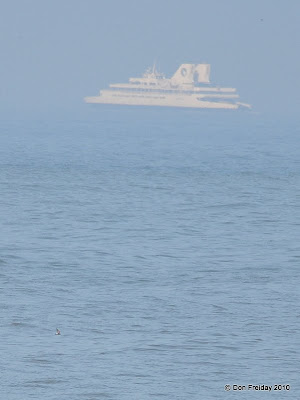Hotline: Cape May Birding Hotline
To Report: call (609) 884-2736, or email sightingsATbirdcapemay.org
Coverage: Cape May, Cumberland and Atlantic Counties , NJ
Compiler: David Lord, Cape May Bird Observatory with additions by Don Freiday
URL: http://www.njaudubon.org ; http://www.birdcapemay.org
This is the Cape May Birding Hotline, a service of New Jersey Audubon Society's Cape May Bird Observatory. This week's message was prepared on Thursday, June 10, 2010. Highlights this week include sightings of BLACK-NECKED STILTS, WILSON’S PHALAROPE, MISSISSIPPI KITE, BLACK TERN, WILSON’S STORM-PETRELS, LESSER-BLACK BACKED GULLS, NORTHERN BOBWHITE, SURF and BLACK SCOTERS, and WHITE-RUMPED SANDPIPERS.
-For up-to-the-minute Cape May sightings information, photos and downloadable birding maps and checklist of Cape May, visit www.birdcapemay.org . Follow rarity sightings, many spring arrivals, and spectacles on www.twitter.com/CMBObirds -
Two BLACK-NECKED STILTS were observed at Cape May Point S.P. on Thursday, June 3, 2010, and were observed last on Tuesday, June 8, 2010 at the big Plover Pond between Cape May Point State Park and the South Cape May Meadows.
A WILSON’S PHALAROPE was seen at the South Cape May Meadows on Saturday, June 5, 2010.
Up to 7 MISSISSIPPI KITES were observed at various locations around Cape Island on Thursday, June 3, 2010, with one last seen at the Villas WMA on Saturday, June 5th 2010.
A BLACK TERN in non-breeding plumage was seen around the Meadows, last noted there on Tuesday, June 8, 2010.
2 WILSON’S STORM-PETRELS were off Cape May Point at St. Peter’s on Thursday, June 10 2010.
A LESSER-BLACK BACKED GULL was seen at the beach near the Meadows on Tuesday, June 8, 2010, and 2 were there the evening of Wednesday, June 9 2010.
Several NORTHERN BOBWHITE sightings have come in during the past few weeks, including one calling at St. Peter’s, one in Goshen, and one at Norbury’s Landing in Del Haven.
ANNOUNCEMENTS:
******CMBO SPRING HOURS are as follows: Northwood Center on East Lake Drive in Cape May Point is open daily, 9:30am to 4:30pm. The Center for Research and Education on Rt. 47 in Goshen is open Tuesday through Saturday, 9:30am to 4:30pm; closed Sundays and Mondays ******
The Cape May Birding Hotline is a service of the New Jersey Audubon Society's Cape May Bird Observatory and details sightings from Cape May, Cumberland and Atlantic Counties. Updates are made weekly. Please report sightings of rare or unusual birds to CMBO at 609-884-2736. Sponsorship for this hotline comes from the support of CMBO members and business members, and should you not be a member, we cordially invite you to join. Individual membership is $39 per year; $49 for families. You can call either center to become a member or visit. Become a member in person and you'll receive a FREE gift (in addition to member discounts in the stores).
Good Luck and Good Birding!
 [Yesterday's American Avocet at the South Cape May Meadows has not been reported today. Photo by Karl Lukens.]
[Yesterday's American Avocet at the South Cape May Meadows has not been reported today. Photo by Karl Lukens.]















































